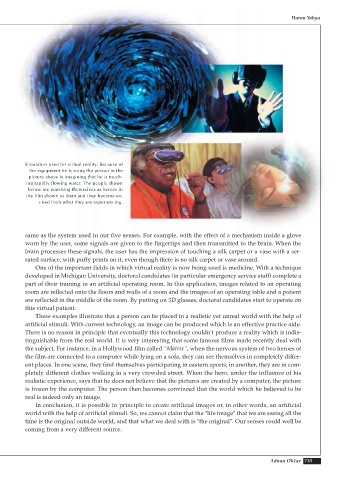Page 733 - Atlas of Creation Volume 3
P. 733
Harun Yahya
Simulators used for virtual reality. Because of
the equipment he is using the person in the
picture above is imagining that he is touch-
ing rapidly flowing water. The people shown
below are watching themselves as heroes in
the film shown to them and they become ex-
cited from what they are experiencing.
same as the system used in our five senses. For example, with the effect of a mechanism inside a glove
worn by the user, some signals are given to the fingertips and then transmitted to the brain. When the
brain processes these signals, the user has the impression of touching a silk carpet or a vase with a ser-
rated surface, with puffy prints on it, even though there is no silk carpet or vase around.
One of the important fields in which virtual reality is now being used is medicine. With a technique
developed in Michigan University, doctoral candidates (in particular emergency service staff) complete a
part of their training in an artificial operating room. In this application, images related to an operating
room are reflected onto the floors and walls of a room and the images of an operating table and a patient
are reflected in the middle of the room. By putting on 3D glasses, doctoral candidates start to operate on
this virtual patient.
These examples illustrate that a person can be placed in a realistic yet unreal world with the help of
artificial stimuli. With current technology, an image can be produced which is an effective practice aide.
There is no reason in principle that eventually this technology couldn't produce a reality which is indis-
tinguishable from the real world. It is very interesting that some famous films made recently deal with
the subject. For instance, in a Hollywood film called "Matrix", when the nervous system of two heroes of
the film are connected to a computer while lying on a sofa, they can see themselves in completely differ-
ent places. In one scene, they find themselves participating in eastern sports; in another, they are in com-
pletely different clothes walking in a very crowded street. When the hero, under the influence of his
realistic experience, says that he does not believe that the pictures are created by a computer, the picture
is frozen by the computer. The person then becomes convinced that the world which he believed to be
real is indeed only an image.
In conclusion, it is possible in principle to create artificial images or, in other words, an artificial
world with the help of artificial stimuli. So, we cannot claim that the "life image" that we are seeing all the
time is the original outside world, and that what we deal with is "the original". Our senses could well be
coming from a very different source.
Adnan Oktar 731

